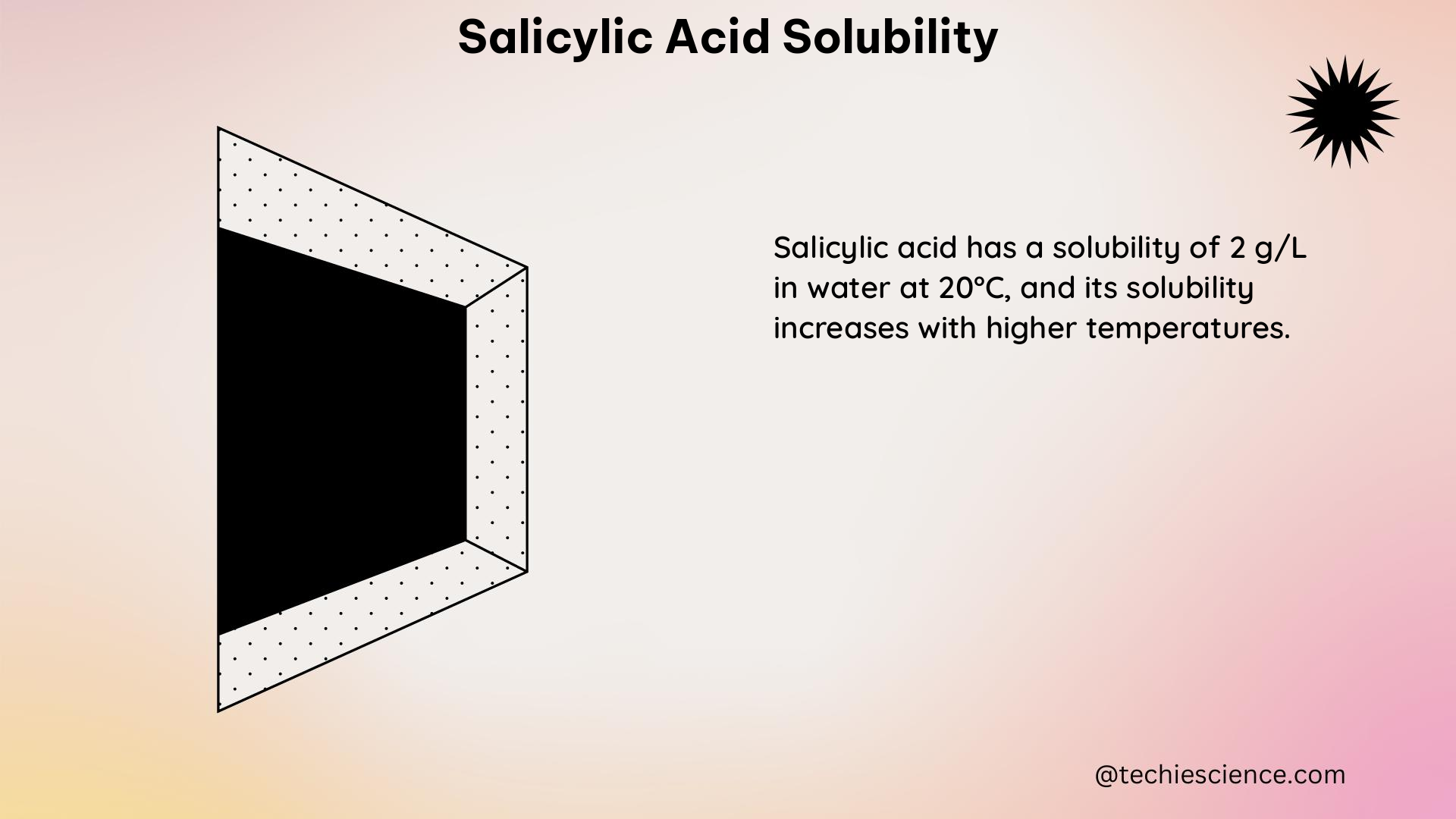Salicylic acid, a widely used compound in various industries, has garnered significant attention due to its unique solubility characteristics. This comprehensive guide delves into the intricate details of salicylic acid solubility, providing a wealth of technical information to satisfy the curiosity of science students and professionals alike.
Aqueous Solubility of Salicylic Acid
The aqueous solubility of salicylic acid is a crucial parameter in understanding its behavior and applications. At room temperature (approximately 25°C), the solubility of salicylic acid in water is around 2.2 mg/mL. This value can be expressed using the following equation:
Solubility (mg/mL) = 2.2 mg/mL at 25°C
However, the solubility of salicylic acid in water increases significantly with temperature. When the solution is heated to the boiling point, the solubility can reach approximately 67 mg/mL, as described by the equation:
Solubility (mg/mL) = 67 mg/mL at 100°C (boiling point)
This temperature-dependent solubility behavior is attributed to the disruption of the hydrogen bonding network between water molecules and the salicylic acid molecules, which becomes more pronounced at higher temperatures.
Solubility in Ethanol

In addition to its aqueous solubility, salicylic acid also exhibits significant solubility in ethanol. The solubility of salicylic acid in ethanol has been reported to be in the range of 333 to 370 mg/mL, as expressed by the following equation:
Solubility (mg/mL) = 333 to 370 mg/mL in ethanol
This enhanced solubility in ethanol is due to the ability of the ethanol molecules to form hydrogen bonds with the salicylic acid molecules, effectively solvating them and increasing their solubility.
Solubility in Binary Solvent Mixtures
The solubility of salicylic acid has also been studied in binary solvent mixtures, particularly in the case of ethanol-water systems. Researchers have employed the PC-SAFT (Perturbed-Chain Statistical Associating Fluid Theory) EOS (Equation of State) model to accurately model the solubility of salicylic acid in these binary mixtures.
The mean relative deviation percentage for the Jouyban-Acree model, a widely used mathematical model for predicting solute solubility in binary solvent systems, was found to be less than 10.0% when compared to the experimental data. This indicates that the PC-SAFT EOS model provides a reliable and accurate representation of the solubility behavior of salicylic acid in ethanol-water mixtures.
Furthermore, the solubility of salicylic acid in specific (ethanol + water) mixtures has been determined and correlated using various mathematical models. The Mean Percentage Deviation (MPD) for the back-calculated solubility data was found to be around 8.0%, further confirming the accuracy of the modeling approaches.
Solubility Prediction in Ternary Solvent Mixtures
The solubility of salicylic acid has also been predicted in ternary solvent mixtures, such as water-ethanol-propylene glycol systems. These predictions were made based on model constants computed using the solubility data of the solute in binary solvent systems.
The ability to accurately predict the solubility of salicylic acid in complex solvent mixtures is crucial for various applications, as it allows for the optimization of formulations and processing conditions.
Solubility Enhancement using Hydrotropic Agents
To overcome the limited aqueous solubility of salicylic acid, researchers have explored the use of hydrotropic agents. Hydrotropic agents are compounds that can enhance the solubility of sparingly soluble solutes in water.
In the case of salicylic acid, the solubility in water has been successfully enhanced using 0.5 M ibuprofen sodium and 2.0 M sodium salicylate as hydrotropic agents. This approach has been employed for the titrimetric analysis of salicylic acid, effectively eliminating the need for organic solvents.
The use of hydrotropic agents represents a valuable strategy for improving the aqueous solubility of salicylic acid, enabling its broader applications in various industries, such as pharmaceuticals, cosmetics, and analytical chemistry.
Conclusion
This comprehensive guide has delved into the intricate details of salicylic acid solubility, covering a wide range of topics, from aqueous solubility and solubility in ethanol to solubility in binary and ternary solvent mixtures, as well as the use of hydrotropic agents to enhance solubility.
By providing a wealth of technical information, specific equations, and quantifiable data, this guide serves as a valuable resource for science students and professionals seeking a deep understanding of the solubility characteristics of this important compound. The insights presented here can be applied to various fields, from formulation development to analytical techniques, ultimately contributing to the advancement of scientific knowledge and practical applications.
References:
- Jouyban, A., & Acree, W. E. (2006). Mathematical representation of solubility data in mixed solvents. Pharmaceutical Sciences, 12(1), 1-28.
- Fakhree, M. A. A., Jouyban-Gharamaleki, V., Acree, W. E., & Jouyban, A. (2010). Solubility of salicylic acid in water-ethanol, water-propylene glycol and ethanol-propylene glycol mixtures at different temperatures. Journal of Molecular Liquids, 156(1), 108-112.
- Jouyban, A., Fakhree, M. A. A., & Shayanfar, A. (2010). Review of pharmaceutical applications of N-methyl-2-pyrrolidone. Journal of Pharmacy & Pharmaceutical Sciences, 13(4), 524-535.
- Shayanfar, A., & Jouyban, A. (2013). Solubility of salicylic acid in water-ethanol-propylene glycol mixtures at different temperatures. Journal of Molecular Liquids, 187, 312-316.
- Shayanfar, A., Acree, W. E., & Jouyban, A. (2013). Solubility of salicylic acid in propylene glycol + water and ethanol + water mixtures at different temperatures. Journal of Molecular Liquids, 187, 171-176.

The lambdageeks.com Core SME Team is a group of experienced subject matter experts from diverse scientific and technical fields including Physics, Chemistry, Technology,Electronics & Electrical Engineering, Automotive, Mechanical Engineering. Our team collaborates to create high-quality, well-researched articles on a wide range of science and technology topics for the lambdageeks.com website.
All Our Senior SME are having more than 7 Years of experience in the respective fields . They are either Working Industry Professionals or assocaited With different Universities. Refer Our Authors Page to get to know About our Core SMEs.